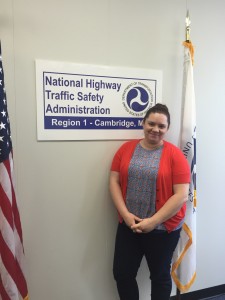I never expected to find myself sitting at a desk, immersed in the day-to-day work of the National Highway Traffic Safety Administration (NHTSA). I study these experts as part of my dissertation work, and now here I am, spending my summer in a completely different world outside of my normal academic life, learning about traffic safety and federal work.
I am an intern in the Summer Transportation Internship Program for Diverse Groups (STIPDG) with the US Department of Transportation (DOT), working specifically for NHTSA. STIPDG, operated through the DC-based nonprofit Washington Center, is a summer program for undergraduate, law, and graduate students to gain on-the-job experience working across all of the DOT’s agencies.
My dissertation research focuses on traffic safety technology and policy development from 1946 through the early 1990s. I use a long-standing and still used concept in traffic safety, the three Es (education, enforcement, and engineering), to discuss and analyze traffic safety regulation, technologies, and relationships between business, government, and community partners. I look at technologies like airbags and seat belts while also focusing on policy issues like drunk driving. I’m hoping to help answer the kinds of questions that NHTSA also asks as part of its work: for instance, what are effective policies and procedures for education and enforcement? How is policy developed? What roles do community partners play in the regulatory and technological development processes? Working for NHTSA this summer has helped me further develop the questions I’d like to ask while writing my dissertation while also answering some of the previous questions I had about how a regulatory agency functions and interacts with various partners.

Renée (right) and her mentor at the NHTSA Region 1 office, Angie (left), at the Ben and Jerry’s factory while they were in Vermont.
As an intern at the NHTSA Region 1 office in Cambridge, Massachusetts (conveniently near my campus office), I am now working on projects that have provided me with perspectives on my dissertation work that I could have only hoped would emerge through my archival research. For instance, during the summer months the regional NHTSA offices handle highway safety plans (HSPs), which are states’ yearly plans for reducing traffic fatalities and injuries. HSPs also detail how states plan to spend federal funds, how their programs fit into federal regulations, and how their performance measures are accurate for the funding levels and fatality and injury rate goals they propose. I have contributed to the review process this summer by reading the HSPs and providing feedback at HSP review staff meetings. I also have had the opportunity to interact with state partners, spending a week in Vermont to see just how that state conducts its traffic safety program and interacts with the federal government.
Some of the most eye-opening situations have occurred in the office, where conversations provide valuable insights into the traffic safety world that may not always be obvious when reading archival material. In the office, for example, there are conversations about what state programs are allowable based on federal regulations, and these conversations lead me to think about how decisions are made and how regulations are interpreted at various levels of government. Now, I feel as though I have a better understanding of the relationships between traffic safety partners and the politics and often business-like world of traffic safety.
Overall, this internship experience has been incredibly valuable to my professional and research development. I have grown as a leader though observations and interactions with both the NHTSA regional staff and the state highway safety offices. Furthermore, the Washington Center’s webinars on topics like networking and federal resume writing, and the week spent in Washington, DC, at the end of the program meeting transportation professionals, have given me new contacts and skills necessary for finding potential employment with the federal government. Although this internship wasn’t explicitly history-focused, I learned to apply my skills as a historian in a completely different setting, as analyzing and commenting on current highway safety documents required that I draw on my knowledge of the history of traffic safety policy development. This experience has bolstered my research skills and, in the end, made me a better historian.
Renée Blackburn is a PhD candidate in the History, Anthropology, and Science, Technology, and Society (HASTS) Program at MIT. Her dissertation research focuses on traffic safety technology and policy development in the period from 1946 until the early 1990s. She also occasionally tweets about traffic safety and other history of technology issues at @retothenee.
This post first appeared on AHA Today.
Tags: AHA Today Career Diversity for Historians Resources for Graduate Students Graduate Education
Comment
Please read our commenting and letters policy before submitting.







